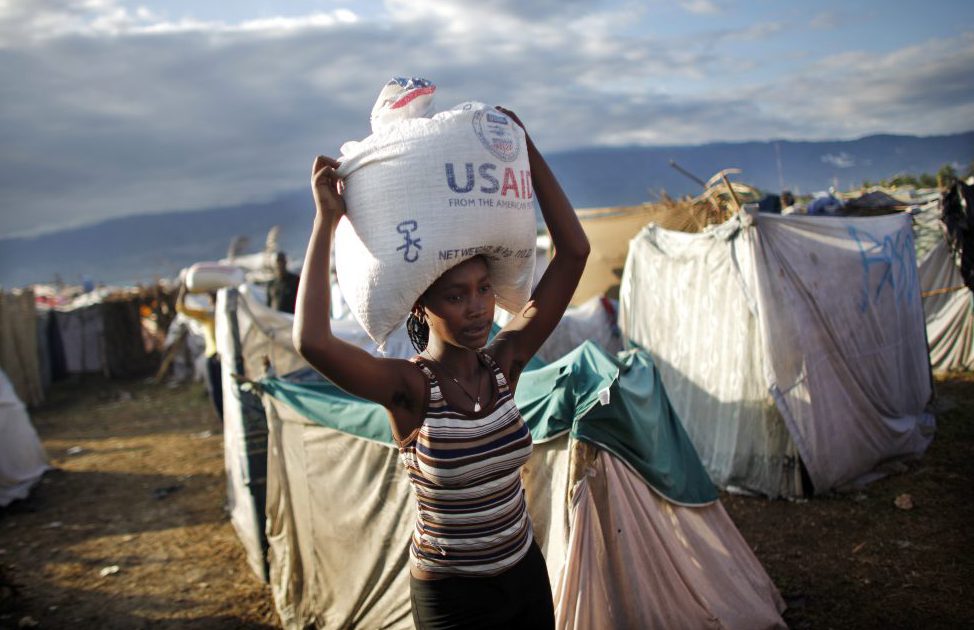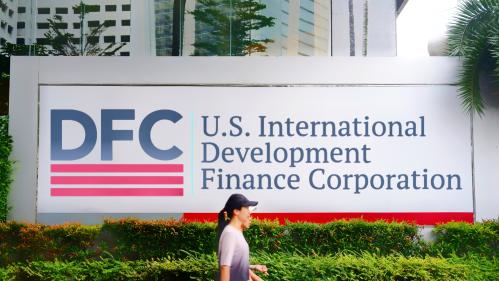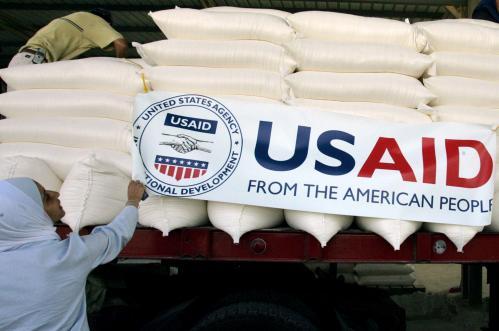From August 2-4, the Global Economy and Development Program at Brookings will host the 14th Annual Brookings Blum Roundtable, “U.S. Foreign Assistance Under Challenge.” The following is one of six briefs on topics to be highlighted at the roundtable.
“Foreign assistance” combines two of the least popular words in United States politics. Since the end of the Cold War, isolationism has slowly weakened internationalism, perhaps because of the growing feeling that foreigners are freeloading on the U.S. as the world’s policeman and problem solver. Some indicators of popular attitudes toward foreign assistance are concerning, although these are not all consistent with each other. A 2016 Pew Survey found far more Americans responding that the U.S. does too much in terms of solving global problems (41 percent) than too little (27 percent). Similarly, a significant majority (57 percent) think that the U.S. should deal with its own problems and let others deal with theirs as best they can.
Adding to the hesitation on getting involved in foreign affairs is the wariness over the role of government in helping people get out of poverty, either at home or abroad. A majority of U.S. survey respondents give government net satisfactory performance evaluations in 10 out of 13 functions— but helping people get out of poverty is the second-worst rated function, with 61 percent believing the government is doing a bad job.
Against this backdrop, most Americans favor cutting foreign aid spending by a large margin, although this effect disappears when respondents are told what proportion of the federal budget is actually spent on aid (97 percent of people believe the U.S. spends more than it does; 76 percent believe it is more than 10 times the actual amount).
Although foreign assistance has a long history of bipartisanship, public sentiment about aid is increasingly partisan. For example, registered Republicans mostly consider that it is not in the U.S. interest to participate in international efforts to forge a more stable world because the problems are so big and complex that not much can be usefully achieved. The reverse is true for Democrats. Trump Republicans have even less favorable views on foreign assistance than others.
What motivates foreign assistance?
One can summarize the basic motives of U.S. foreign assistance as love, trust, and fear. “Love” captures humanitarian concern for the world’s poorest, so aid that saves lives, feeds the hungry, and improves the lot of women and children is strongly supported. “Trust” reflects a desire to help those who share our values. For example, mutually beneficial trade and investment relationships can be built on shared values of human rights, labor, environmental standards, and democratic governance. “Fear” of insecurity initially was about combining development assistance and military assistance to combat conflict and terrorism, but it is increasingly concerned with managing other global problems that could hurt the U.S., such as climate change (for those who believe solutions can be man-made) and pandemics.
Figure 1 suggests that aid is relatively balanced across the three components, with several large and significant components in each category. In fiscal year 2016, peace and security accounted for 25 percent of the $35.5 billion foreign assistance budget; economic growth, good governance, and democracy accounted for another 20 percent; investing in people received 30 percent; humanitarian assistance 20 percent; and the remaining 5 percent was for administration and program support. Looked at by sector, health (including the President’s Emergency Plan for AIDS Relief (PEPFAR)) and humanitarian assistance comprise upwards of $8 billion apiece. Looked at geographically, Israel, Egypt, Afghanistan, and Jordan together add $7 billion.
The U.S. is the largest donor in the world, accounting today for just under 20 percent of total aid, somewhat less than its 25 percent share of global output (Figure 2). The end of the Cold War resulted in a decade-long fall in total foreign assistance and in the U.S. share. This was then reversed; from 1997 to 2005 global aid and the U.S. share both rose strongly in real terms. The two big drivers of this were debt relief and support for health, including through PEPFAR, Gavi, the Vaccine Alliance, and the Global Fund to Fight AIDS, Tuberculosis, and Malaria. From 2005 until today, aid has been rising globally while the U.S. share has fallen.
The president’s budget for fiscal year 2018 calls for a reduction of about one-third of the volume of aid and commits to four key national priorities for the State Department and U.S. Agency for International Development:
- Defending U.S. national security
- Asserting U.S. leadership and influence
- Fostering opportunities for U.S. economic interests
- Ensuring effectiveness and accountability to the U.S. taxpayer
In terms of Figure 1, the president’s budget suggests a shift in composition toward national security and a cut in other areas. In terms of Figure 2, the budget would bring the share of U.S. assistance down to its lowest levels in 40 years, even lower if other countries are persuaded to increase aid to fill gaps created by U.S. withdrawal.
The evolving development landscape
Development cooperation today no longer resembles what it was in 1961 when the Foreign Assistance Act was enacted. Global disruptors to the aid landscape include:
- More attention to the national interest (of donors) rather than to altruism alone
- The emergence of China as a major player in development cooperation (not aid, but cheap loans)
- The emergence of large-scale private aid, both philanthropic, through impact investors, and through adoption of better business practices by large corporations
- Demands for cooperative solutions to deal with fragile states, refugees, climate change, and pandemics
National interest
The “national-interest first” movement, in the U.S. as well as in several European countries, has captured an anti-globalization, anti-foreigner, anti-immigrant, and anti-multilateral sentiment. For many years, aid has been used to plant the flag on foreign shores. In today’s environment, within the U.S. administration as well as other countries, there is even more desire to use aid as a key instrument for maintaining leadership and trust in global, or at least regional, affairs.
For the U.S., foreign assistance has long been viewed as integral to its leadership in global affairs and trust among allies, but the effectiveness of aid is doubted. Large majorities in America believe that aid ends up in the pockets of corrupt governments overseas. (This response should not be interpreted as merely ignorance of fact—noted academics, including Nobel Laureate Angus Deaton, share the same opinion.) The median response in a poll conducted in December 2016 by the Program for Public Consultation at the University of Maryland to “what percentage of U.S. aid money that goes to poor countries ends up helping the people who really need it” is 10 percent. This figure is somewhat higher if aid is channeled through a nongovernmental or religious organization, but never reaches levels that would suggest popular support. In similar vein, there is overwhelming aversion (over 90 percent) to providing aid through recipient-country government channels. From this perspective, identifying aid with what is good for America is a useful strategy.
China
The Belt and Road Forum for International Cooperation, held in Shanghai in May 2017, was the most recent symbol of China’s intention to use development cooperation as a key tool of its foreign relations. The Belt and Road initiative covers all Asian countries, along with East Africa and portions of other resource-rich African countries. What is surprising is the scale at which China has proceeded.
The two largest Chinese banks, the China Development Bank and the China Export-Import Bank, already hold roughly the same total international assets ($680 billion) as all the Western multilateral development banks put together. In addition, China has announced concessional funds totalling another $116 billion. The two new multilateral development banks that it helped co-found, the Asian Infrastructure Investment Bank and the New Development Bank, are up and running. AIIB’s investment capacity could be as much as $250 billion by 2020 according to its articles of agreement. By then it could have more paid-in capital than the World Bank.
Of course, there is no guarantee that China’s overseas development projects will succeed. The collapse of the Sigiri bridge in Kenya during construction is but the most recent example of a failed megaproject. Established aid agencies have developed complex protocols on procurement, consultation, environmental and social standards, and creditworthiness to ensure that projects meet international standards. Left to its own devices, China could well trip up on these issues. Yet, given the high political priority attached to its schemes, it would be unwise to rely on China self- destructing.
Business partnerships and “beyond aid” instruments
Private philanthropy from the 30 OECD Development Assistance Committee countries is esti-mated at $64 billion per year (as compared to $137 of official development assistance from these same donors). In some countries, notably the U.S., private charitable giving ($44 billion annually) dwarfs official aid ($33 billion) and has continued to grow faster over the past 10 years. In addition to aid, social impact businesses hold about $40 billion in assets in developing countries and are adding $7 billion each year.
The new game changer is that business leaders today see major opportunities in sustainable development. A Business and Sustainable Development Commission report identified $12 trillion in new opportunities in food and agriculture, cities, energy and materials, and health and well- being. A growing body of academic evidence shows that businesses with sustainability embedded into core operational practices have higher long-run profits. Business can help drive development if incentives are aligned—but that requires policy and regulatory reform in both host countries and source countries. The deregulatory thrust in the U.S. (including reversal of Sections 1502 and 1504 of the Dodd-Frank Frank Wall Street Reform and Consumer Protection Act), coupled with worries about corporate welfare provided by agencies like U.S. Overseas Private Investment Corporation (OPIC), may make it harder for U.S. businesses to credibly commit to being pro- development.
Fragile states, global problems, and multilateralism
Aid donors prefer their funds to go to low-income countries that are themselves trying to create conditions conducive to development. The Millennium Challenge Corporation (MCC) was created on just such principles. But MCC’s country allocation rules can generate inflexibilities for solving problems when upper-middle-income countries need support.
One example is the refugee problem in the Middle East. Large numbers of Syrian refugees to Jordan and Lebanon were threatening to overwhelm these countries and spread instability throughout the region. By its rules, the World Bank was unable to help underwrite the costs. After protracted negotiations, a workaround was found to build special economic zones where refugees could work and gain some livelihood to support themselves.
Global problems like conflict, pandemics, and climate change are spreading, but the burden sharing for funding solutions is under stress. Multilateral institutions, where burden sharing is done in an institutionalized and formal way, do not always have the mandate or resources to step in. Core activities are being under-funded, while donors instead use multilaterals as implementing agencies for their own bilateral programs. While hard to measure, there is a sense that the provision of global public goods has declined at a time when the need for them is higher than ever. Without such public goods, the world is left to deal with the consequences, almost always at vastly greater cost; hence the newfound emphasis on prevention and resilience as a cost-effective way of using aid, an analytically appealing idea but one that is politically challenging. How can the prevention of a bad outcome be made visible?
Speaking for Pittsburgh
President Trump’s “I represent the citizens of Pittsburgh not Paris” comment highlights the need to communicate better to voters why aid is in their own interest and to get them to pressure their Congressional representatives on the issue. There is a strong base—perhaps a majority—of popular support for maintaining or raising aid volumes in principle, but only under certain conditions.
Some narratives about pandemics, saving lives, gender equality, and humanitarian assistance tap into core American values and garner strong support. Other pro-foreign aid narratives are challenged by the perception that foreign governments are corrupt, multilateral institutions are opaque, and global problems are too complex to guarantee results.
Aid has long enjoyed bipartisan support, but views are becoming more polarized into “pro” and “anti” camps. This division obscures an important conversation about how to reform aid and aid institutions—both bilateral and multilateral—to improve effectiveness in the context of tight budgets and a rapidly shifting global environment.
The Brookings Institution is a nonprofit organization devoted to independent research and policy solutions. Its mission is to conduct high-quality, independent research and, based on that research, to provide innovative, practical recommendations for policymakers and the public. The conclusions and recommendations of any Brookings publication are solely those of its author(s), and do not reflect the views of the Institution, its management, or its other scholars.
Brookings gratefully acknowledges Richard C. Blum and the Rockefeller Foundation for their generous support of the 2017 Brookings Blum Roundtable.
Brookings recognizes that the value it provides is in its absolute commitment to quality, independence, and impact. Activities supported by its donors reflect this commitment.






